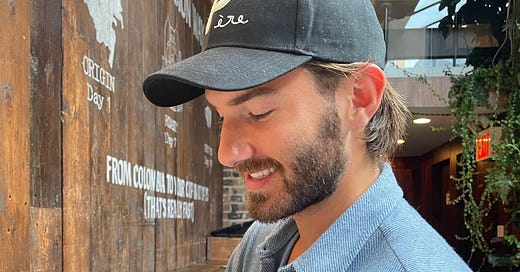Dear Kool Health Crew,
Happy Wednesday yall!
I’m currently enjoying a shot of espresso at Devoción coffee in Williamsburg, NY.
It’s essentially a farm-to-table coffee restaurant. Their whole slogan is “From Colombia to your cup in 10 days.” I learned that they source from organic farmers as well.
And I have to say, this coffee is freaking incredible. No jitters. No anxiety. Just pure, motivating bliss.
Also I don’t feel like shitting my pants.
Drinking regular coffee gives me anxiety and leaves me feeling like a mess.
But this espresso shot I’m enjoying right now? It’s different.
So, it got me thinking—knowing what I know about health—why does a fresh, organic cup of coffee make me feel like this, whereas regular coffee gives me anxiety and pumps obnoxious amounts of adrenaline through me?
My Friend Kyle’s Coffee Experience
Take my friend Kyle, for example.
He loves his morning cup of joe. He recently started going to Starbucks after finding a new job. But here’s the thing: when he drinks Starbucks coffee, he experiences the same pain I deal with—he gets way too geeked out, can’t work for long, doesn’t eat all day, and snaps at whoever comes his way.
One day, we were talking and he hit me with this:
“Jack, why does Starbucks coffee make me tweak?”
With my weird biohacker brain, I wanted to say:
“Well, your electron transport chain is most likely off because caffeine is a diuretic, and you’ve lost essential minerals, which imbalanced your blood-brain barrier. You might just die in 5 minutes….”
But instead, I told him:
“I’ll look into it.”
And look into it, I did. And boy, did I find some information about coffee—particularly why some coffee gives you that heart attack feeling, yet the fresh, organic stuff doesn’t.
So here we go yall. I hope by the end of this you come out with a fresh mind and a fresh cup of joe knowing what coffee to avoid, and the coffee you should be drinking.
The Two Big Reasons Why Coffee Is Making You Tweak
1. Coffee is moldy.
Mold. The silent villan. It lurks in the night….. its also on our coffe beans.
When I drink non-organic, moldy coffee, my immune system kicks into overdrive due to the toxins entering my body.
Most commercial coffee beans are stored in vats for extended periods, creating the perfect breeding ground for mold. And where there’s mold, there are mycotoxins—specifically a toxin called Ochratoxin A (OTA).
This is a beautiful article that illustrates the ubiquity of these mold toxins.
Why should you care?
Because OTA is associated with some pretty severe health risks, including
- Cancer
- Brain damage
- Hypertension
- Kidney disease
The effects might not be immediately noticeable. However, chronic exposure to low doses of this toxin over time can lead to serious health issues.
Also for Kyle I found that Starbucks is one of the worst culprits for mold and non organic coffee.
This explains why my generic coffee leaves battling my body rather than energizing it. The mold in the coffee impairs cognitive function—the very thing I’m trying to enhance by drinking coffee in the first place!
Lets dive into the second culprit.
2. Pesticides.
According to PRWeb, 91.5% of coffee worldwide is treated with pesticides, herbicides, and other chemicals, while only 8.5% is certified organic. Brazil, the world's largest coffee producer, has increased its use of pesticides by almost 800% since 1990.
Pesticides are horrible for your health. They smash your gut microbiome, over activate your immune system, and are toxic and carcinogenic.
You don’t want to be drinking coffee with pesticides on it.
Why Fresh Coffee Feels So Good
Ok we understand why you, Kyle and myself feel like ass when we drink regular joe. The coffee is filled with mold toxins and pesticides.
But if we change our beans, we transform our morning cup into a superfood elixir. One that is good for you and provides you with all those amazing benefits that the coffee bean has. The polyphenols, the b vitamins, etc.
Freshly roasted coffee not only tastes better but is also less likely to contain harmful mycotoxins.
And when you choose organic, you’re avoiding the pesticides that can further damage your health and the environment.
According to Dave Asprey, the creator of Bulletproof Coffee,
“Mold toxins in coffee are one of the most significant health problems in the modern world, especially for people with autoimmune conditions or those who suffer from chronic fatigue.”
Practical Guide: How to Find High-Quality, Mold-Free Coffee
Now that we’ve uncovered the problem, how can you ensure that your coffee is free from these harmful contaminants?
Here’s a practical guide to help you make the best choice for your health:
1. Choose Organic Coffee: Always opt for organic coffee. Organic farming practices significantly reduce the risk of mold and pesticide contamination, making your coffee both healthier and more environmentally friendly.
My favorite coffee is Kion Organic Coffee which is known for their rigorous testing for mold and other contaminants. My favorite is the medium roast.
Discount 10% off with KOOLHEALTH
Here is a list as well if Kion is not your jam.
2. Check the Roasting Date: Freshness is key. Always check the roasting date on your coffee bag and aim to consume the beans within a few weeks of that date. The fresher the coffee, the lower the risk of mold growth.
3. Ask Questions at Coffee Shops: When visiting coffee shops, don’t hesitate to ask about their sourcing practices. Are the beans organic? How long have they been stored? A good coffee shop will be transparent about these details.
4. Proper Storage at Home: Store your coffee beans in an airtight container in a cool, dark place. Avoid buying large quantities at once; instead, purchase smaller batches to ensure freshness.
5. Experiment and Observe: Try switching to high-quality, mold-free coffee and observe how it affects your body. Notice any changes in your energy levels, cognitive function, or overall well-being.
Conclusion: Elevate Your Coffee Experience
Your daily coffee ritual doesn’t have to be a gamble with your health.
We can finally drink our coffee and have it be good for us. No more jitters, anxiety and depresso. More espresso less depresso.
By choosing organic, mold-free coffee and paying attention to where your beans come from, you can transform your morning brew into a nourishing, energizing experience.
So, the next time you reach for a cup of coffee, remember that not all beans are created equal.
Choose wisely, and you’ll not only enjoy your coffee more but also protect your health in the long run.
Love you!!!
Thanks for reading and being a part of this community.
How did it go? Did this article help you?
Did you learn something useful and practical
What could we do to improve? Your feedback is what makes this journey together so powerful.
Ready to overcome the obstacles holding you back?
If you’re struggling with low energy, managing stress, or staying fit while balancing a demanding job, let’s dive deeper.
We’ll tailor strategies that help you stay sharp, feel energized, and crush your health goals—even with a busy schedule. Book a call with me today and let’s create a personalized plan that fits your life.
With Love,
Jack (Kool Health)
Transforming the ordinary into the extraordinary.
Disclaimer
The information in this article is for educational purposes only and is not medical advice. Always consult a healthcare provider before starting any new treatment or supplement, especially if you have medical conditions or take other medications. Individual results may vary.
Consider seeing a specialist in functional medicine.






Misread the title as “Is Starbucks coffee making you twerk” - OTAs really are getting to me, I guess. Great read, came away with some legit learnings and inspiration to buy organic. 👊
Oooh, terrifying 😂 I rarely drink coffee shop bought coffee but this is very good to know!!! Mold + pesticides 😭😭😭